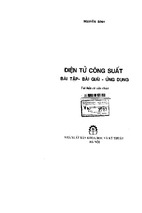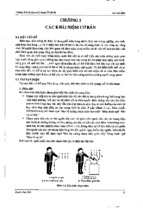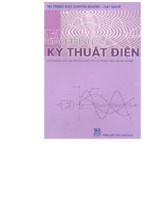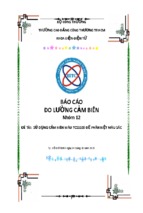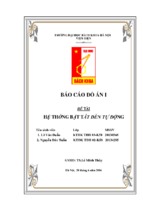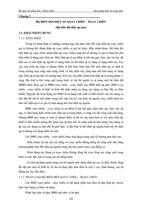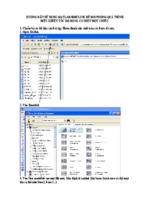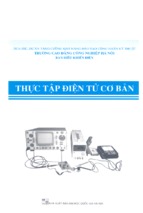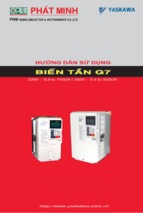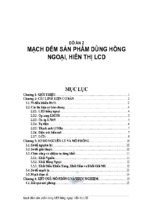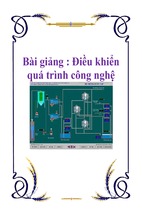Mô tả:
Automated Guided Vehicles/
Self Guided Vehicles
Chapter 7
Topics
History
What is AGVs /AGVSs
Components of AGVS
Types of AGVS
Important issues for the AGVS
Design Features
System design of AGVS
Automated Guided Vehicle System
Transport material from loading to unloading
stations
Highly flexible, intelligent and versatile materialmaterialhandling systems.
A very flexible solution for the problem of
integrating a new automated transportation line
into an existing transportation environment by
using automatic guided vehicle.
History
First AGV developed in 1954 by
A.M.Barrett,Jr.
Using a overhead wire to guide a modified
towing truck pulling a trailer in a grocery
warehouse.
Subsequently, commercial AGV were
introduced by Barrett.
1973, Volvo developed automated guided
vehicles to serve assembly platforms for
moving car bodies through its final assembly
plants.
Later, Volvo marketed their unit load AGVs to
other car companies.
What is AGV?
Driverless Vehicle
Electric motors, battery powered
Programming capabilities
Destination
Path selection
Positioning
Collision avoidance
System Discipline
Modern AGVS
Modern AGVs are computercomputercontrolled vehicles with onboard
microprocessors.
Position feedback system to
correct path
Communication between
vehicles via system controller
RF communication
Electric signals
System management computers
Optimising the AGV utilisation
Tracking the material in transfer
and directing the AGV traffic.
traffic.
SPECIFICATIONS:
Length
63.25"
(160.7cm)
Width (with kick panels)
34.50"
(87.6 cm)
Height (Overall)
Height (Platform)
Platform Size
42.5"
(107.0 cm)
7.625"
36" x 34"
(19.4 cm)
(91.5 cm x 86.4 cm)
Weight (without batteries)
302 lbs
(137.3 kg)
(with batteries)
526 lbs
(239.1 kg)
1,300 lbs
(590.9 kg)
1,800 lbs ea
(818.2 kg)
36"
(91.5 cm)
<.5"
(<1.3 cm)
Unloaded @ 120 fpm (36.6
meters/minute)
<.25"
(<.64 cm)
Loaded w/804 lbs (365.4 kg) @ 120
fpm (36.6 meters/minute)
<5.0"
(<12.7 cm)
+/-1.25"
(+/-3.2 cm)
Frame Load Capacity
Castor Capacities (up to )
Turning Radius (standard)
Stopping Accuracy (programmed)
Loaded w/780 lbs (354.5 kg) or
Unloaded
Emergency Braking Accuracy:
Queing Accuracy (adjustable)
Tracking Accuracy
+/-.5"
(+/- 1.27 cm)
Drive Motor Specifications:
Output
Load Capacity
Gear Ratio
300 watts
1325 lbs
602 kg
24.0:1
Speed (Programmable from 0-180 fpm)
Automatic (standard)
120 fpm
Manual
180 fpm
36.6 mpm
54.9 mpm
Details from Paragon, Inc.
Components of AGVS
The Vehicle – No operator
The guide path – The path for the AGV
The control Unit – Monitors and Directs system operations including
feedback on moves, inventory, and vehicle status.
The computer interface – Interfaces with other mainframe host
computer, the automated storage and retrieval system (AS/RS), and
the flexible manufacturing system.
Types of AGVSs
AGVS towing vehicle
AGVS unit load carriers
AGVS pallet trucks
AGVS forklift trucks
AGVS light-load transporters
lightAGVS assembly-line vehicles
assembly-
AGVS Towing Vehicles
First type of AGV introduced.
Towing vehicle is called an automated
guided tractor
Flatbed trailers, pallet trucks, custom
trailers can be used.
Generally, used for large volumes
(>1000 lb) and long moving distances
(>1000 feet).
Load Capacity:1,500 lbsVehicle
Type:Laser Guided Tugger
AGV Products, Inc
AGVS Unit load Carriers
To transport individual unit load onboard
the vehicle.
Equipped with powered or non-powered
nonroller, chain or belt deck, or custom deck.
Loads can be moved by Pallet truck,
forklift truck, automatic loading/unloading
equipment, etc.
Load Capacity3,000 lbs
Vehicle Type: Unit Load with
variable Height Conveyor
AGVS Pallet Trucks
No special device is needed for loading
except the loads should be on pallet
Limited to floor level loading and
unloading with palletized load
Widely used in distribution functions
Capacity 1000-2000 lb
1000Speed > 200ft/min
Pallet truck can be loaded either
manually or automatically
AGVS Forklift Trucks
Ability to pickup and drop palletized
load both at floor level and on stands.
Pickup and drop off heights can be
different
Vehicle can position its fork according
to load stands with different heights
Very expensive
Selected where complete automation
is necessary/required.
Load Capacity: 1,500 lbs Vehicle
Type: Laser Guided Fork Lift
AGV Products, Inc
AGVS Light Load Transporters
Capacity < 500lb
To handle light and small loads/parts over moderate
distances
Distribute between storage and number of workstations
Speed 100ft/min, turning radius 2ft
For areas with restricted space
AGVS Assembly-Line Vehicles
AssemblyVariation of an light load transporter
For serial assembly processes
As the vehicle moves from one station to another,
succeeding assembly operations are performed
This kind provides flexibility for the manufacturing
processes
Lower expenses and ease of installation
Complex computer control and extensive planning is
required to integrate the system.
Important issues for AGVS
Guidance system
Routing
AGVS control systems
Load transfer
Interfacing with other subsystems
AGVS Guidance system
The goal of an AGVS guidance system keep the AGV on
track/predefined path
One of the major advantage of AGV is ease in modification
given by the guidance system for changing the guide path
at low cost compare to conveyors, chains, etc.
Another benefit is: guide path is flexible which means
intersection of path is possible.
Generally, guide path does not obstruct another systems.
The guidance systems can be selected based on the type
of AGV selected, its application, requirement and
environmental limitation.
WireWire-guided
Optical
Inertial
Infrared
Laser
Teaching type
WireWire-guided:
An energized wire is rooted along the guide
path.
The antenna of the AGV follows the rooted wire.
Optical:
Colorless florescent particles are painted on the
concrete/tiled floor.
Photosensors are used to track these particles.
Inertial:
The guide path is programmed on a
microprocessor which is fixed on the AGV
Sonar system is incorporated for finding
obstacles.
Infrared:
Infrared light transmitters are used to detect
the position of the vehicle.
Reflectors are affixed on the top of vehicle to
reflect the light.
Laser:
Laser beam is used to scan wall-mounted
wallbarbar-coded reflectors.
Accurate positioning can be obtained.
Teaching type:
AGV learns the guide path by moving the
required route.
Sends the information to the host computer.
AGVS Routing
A routing system is used to select the
vehicle which is positioned with the
optimum path.
A network controller gives the destination,
while the on-board controller navigates the
onvehicle.
Commonly used methods:
Frequency select method
PathPath-switch select method
Frequency select Method
At the bifurcation of path (decision point),
the vehicle reads a code in the floor in the
form of metal plate, or coded device.
The vehicle selects one of the frequencies
as per the direction required.
The frequencies are always active.
A continuous wire is used to loop the
frequencies.
PathPath-Switch Select Method
Path is divided into segments.
One frequency is used
Segments are switched On/Off by
separate floor controls according to the
path to be followed.
Less preferred over Frequency select
method.
AGVS Control Systems
Computer controlled system
AGV
The path controller controls
Controller for
the guidepath of AGVS.
guided path
Sends information to AGVS
process controller.
Process controller directs
Display
terminal
movement of vehicles
Interchanges information with the host computer
Most Expensive and complex type of control.
Guided
path
AGVS process
controller
Display
terminal
Host
computer
Remote dispatch control system
Instructions are issued to vehicle from a remote control station via a human
operator.
Control system sends instruction directly to vehicle.
The human operator does have the direct control over the vehicles.
This type of system generally have automatic loading and unloading
capability.
Manual control system
The destination is fed on the onboard control on the vehicle via a human
operator after loading.
The vehicles moves through the guide path for the destination by itself.
Reaching destination, it stops for the human operator to direct unloading.
Least expensive control system.
Efficiency depends on operators performance and varies.
- Xem thêm -

